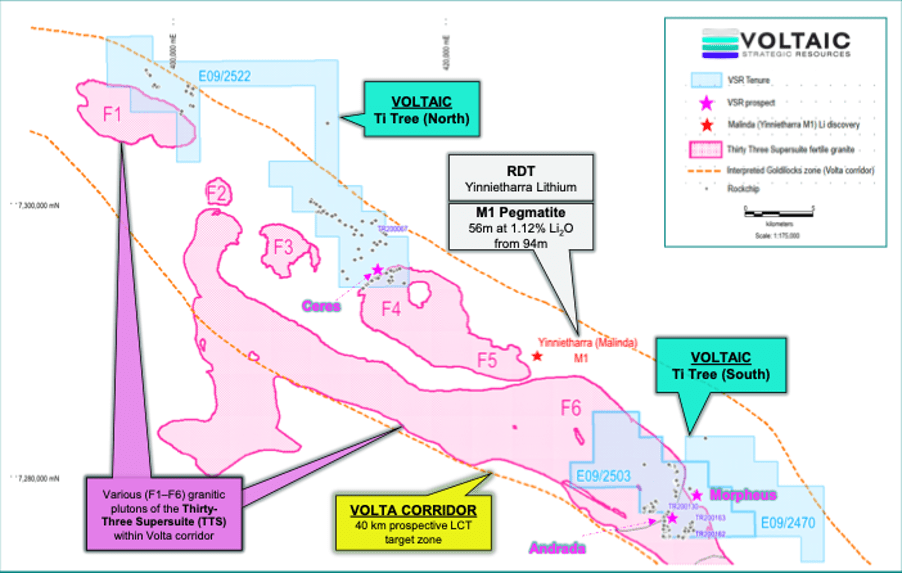Voltaic confirms three lithium targets at Ti Tree project

LCT anomalism has been identified across the entire Volta corridor with < 5% of the tenure tested to date. Pic via Getty Images.
Maiden geochemical sampling at Voltaic Strategic Resources’ Ti Tree project in WA have confirmed lithium-fertile pegmatites across the entire project area.
A total of 228 samples were collected across Ti Tree North and South, resulting in the expansion of the Volta corridor to 40km strike length and the identification of 3 priority drill targets – Andrada, Ceres and Morpheus.
Anomalous tantalum and caesium were also identified within Li-enriched pegmatitic rockchips, confirming the presence of a lithium-caesium-tantalum (LCT) system (peak: 887 ppm Li2O, 205 ppm Ta2O5 & 320 ppm Cs2O respectively).
LCT pegmatite system potential
The company believes there is prospectivity for hosting a true LCT system, as the Yinnietharra (Malinda) lithium discovery was initially identified as a prospect from fertility analysis undertaken by Segue Resources Ltd in 2016, which demonstrated that the Thirty-Three Supersuite (TTS) granitic belt is the likely source of lithium mineralisation in the region.
And the TTS underlies both the Yinnietharra lithium discovery and Voltaic’s Ti Tree tenements (the 80 km strike Volta corridor).
“Through the use of established best practices in lithium exploration, Voltaic have clearly demonstrated that the granites (and associated schists) within our tenure are fertile and the respective pegmatites are of comparable calibre to those at the neighbouring Yinnietharra project,” Voltaic (ASX:VSR) CEO Michael Walshe said.
“The Ti Tree project has never been systematically explored for Li, providing Voltaic with an outstanding opportunity to make a ‘greenfields ‘discovery in a region that has become a Li exploration hotspot.
“Indeed, it could be argued that the TTS granites that underlay Ti Tree and Yinnietharra are comparable to those at world-class lithium deposits such as Pilgangoora in Western Australia, in terms of both fertility and fractionation, and the Gascoyne region could soon emerge as Australia’s next major lithium supply hub.”
Red Dirt Metals (ASX:RDT) are actively drilling 90,000m into the Yinnietharra project and initial drill results for the ‘M1 pegmatite’ include 56m at 1.12% Li2O from 94m.
This shows “significant down-dip continuity with excellent Li2O grades from surface, which is very encouraging for the entire region,” Voltaic says.

40km strike length ‘goldilocks’ corridor
From the fertility analysis of these initial rockchips, Voltaic has identified a significant increase in the prospective LCT “goldilocks” corridor (covering potential fertile parental granitic plutons) from 22km to 40km strike length within the Ti Tree tenure.
The company is now planning Phase 3’ of ground reconnaissance at Ti Tree for February/March 2023 which will comprise further geochemical sampling and planning for the subsequent regional soil sampling campaign.
In addition, a high-resolution UAV drone survey is planned for February 2023 and will provide detailed high-resolution imagery to assist with regional geological mapping and identification of pegmatite outcrops.
Detailed geophysical and structural interpretation analysis is underway in collaboration with Southern Geoscience Consultants (SGC), to complement the company’s pipeline of targets, and follow-up geophysical surveys may commence in March/April 2023, depending on the results from SGC’s assessment.
This article was developed in collaboration with Voltaic Strategic Resources Limited, a Stockhead advertiser at the time of publishing.
This article does not constitute financial product advice. You should consider obtaining independent advice before making any financial decisions.
Related Topics

UNLOCK INSIGHTS
Discover the untold stories of emerging ASX stocks.
Daily news and expert analysis, it's free to subscribe.
By proceeding, you confirm you understand that we handle personal information in accordance with our Privacy Policy.








